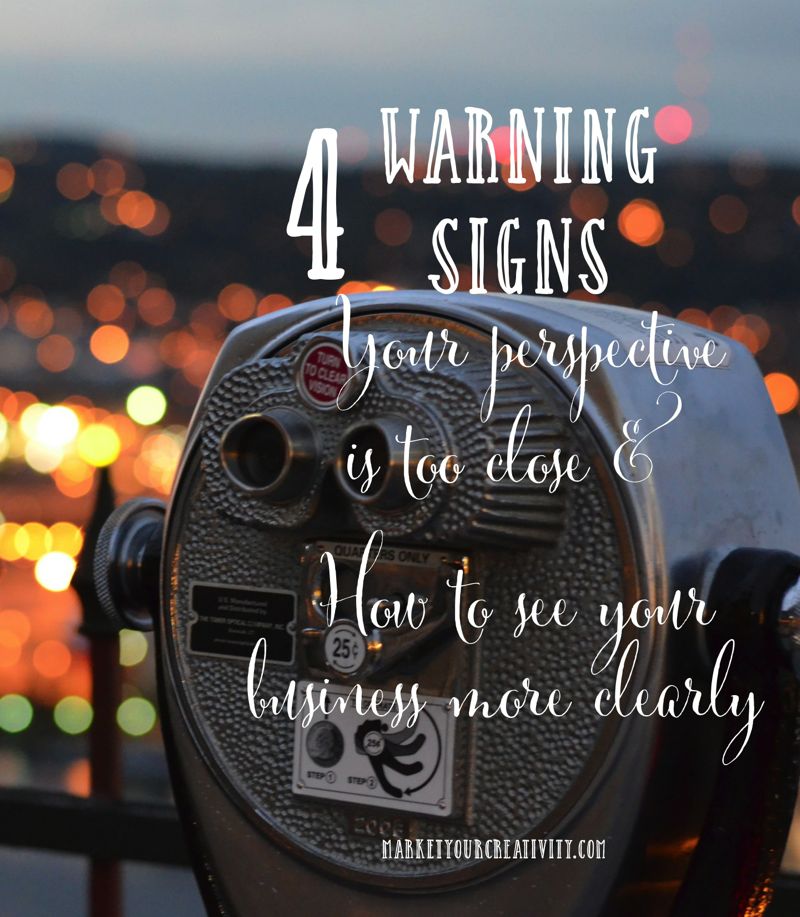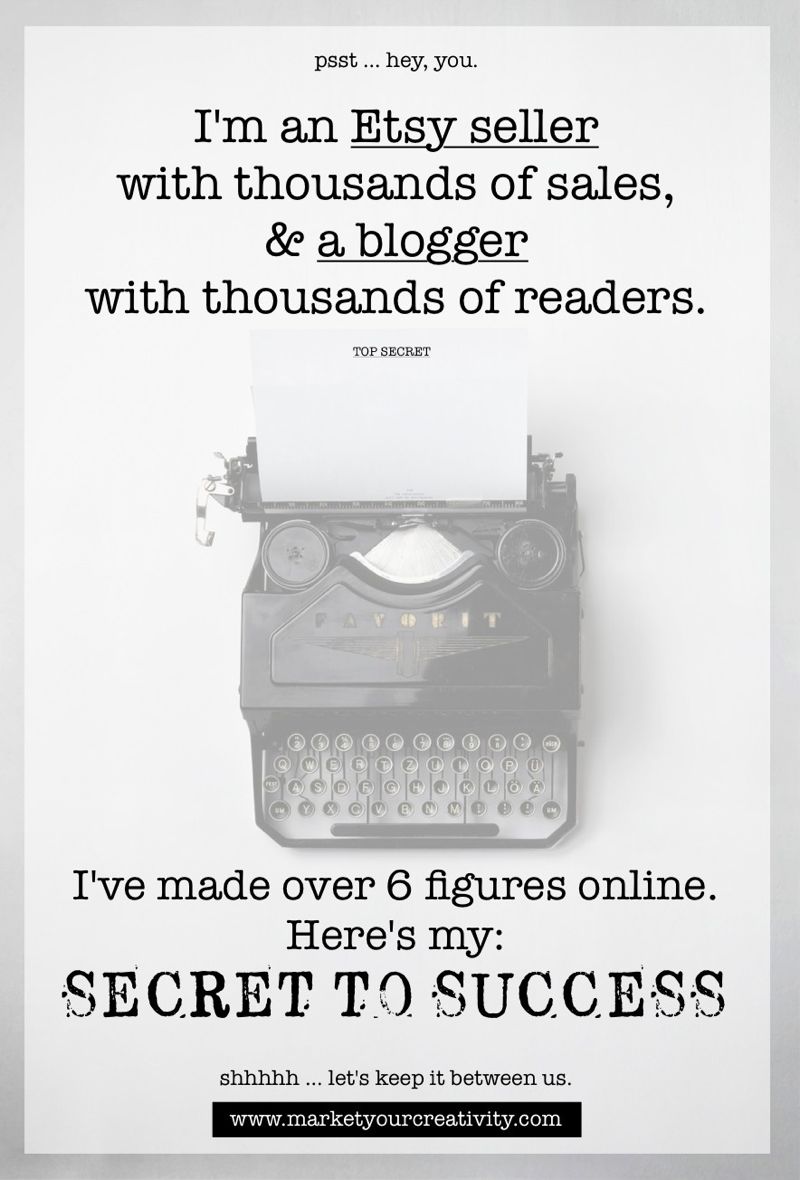Creative business is based on personal passion, and therefore, your perspective is almost always too close. If you’re the owner of a website or online shop, you probably know exactly what I mean. The business feels more like it’s “in here, in front of me” in your home, rather than “out there” serving the world. And that’s something you’re better off correcting as soon as possible. Here are …
#1 You feel stuck and frustrated
The first three years of business is just planting the seed. Like anything else, you have to start at the beginning, and the beginning of business is always laying the foundation for a promising future of growth. That’s realistic for small businesses, but most people don’t come in expecting to pay their dues. This is just one of the reasons you’ll hear so much moaning and groaning in the handmade forums. People want success yesterday already; but if you enter the marketplace prepared for the long haul, you’ll survive: outwit, outlast, and outsell the complainers.
This is not the time to be impatient. This is the time to allow yourself the space and grace to begin. Anybody can want success yesterday already, but very few are actually willing to work for it! If you’re feeling frustrated or stuck, take a step back and realize how far you’ve come–and what you’re already doing that most people don’t have the courage to try!
#2 You feel unoriginal
A lot of folks question their business idea because “there’s already so many jewelry designers/ photographers/ painters/ etc out there.” I’d like to clear up this common misconception once and for all: that’s your own insecurity, and it’s a personal belief that you’re turning into a business decision. Instead, stick to the facts:
- You don’t have to strive to be original; you already are.
- You know how to tap into your imagination and create something from nothing. That’s amazing; start showing it off!
#3 You’re waiting for something to happen
What’s a girl have to do to get a “big break” around here?! Are you doing the rounds: checking email, Facebook and Pinterest a thousand times a day to see if anything new is happening? Ugh! Join the club.
There’s no better way to slow down and grow frustrated than to stop progressing. Sometimes, sales slow. Keep working. Keep creating. Keep plugging away. If you’re miserable in business, it’s typically because you’re waiting for something to happen. Stop it. Get moving, and go make something happen.
#4 You take things personally
When you knit a scarf for your friend or paint a vase for your mother, that’s a hobby. When you list that creation online for sale, that hobby creation becomes business. However, most handmade sellers fail to realize this.
So, the first step here is to open yourself to feedback, and remember that less than satisfactory reviews and concerns are people letting you know how to turn them into (or keep them as) customers. Here’s how to see your business more clearly:
The CEO Day
You wear many hats in your creative business, and you probably wear a few more in your personal life! Juggling your different “jobs” + organizing new ideas and projects can quickly become overwhelming. A CEO day is one of the very best ways to manage it all.
In creative business, it’s important to remember and respect all the different hats you need to wear. Your CEO hat (planning, review, decision-making) is as important as your secretary hat (admin, organization and scheduling) and vice versa. In order to run an efficient operation, be sure to take time for these things every month.
What you’ll need:
#1 REFLECTIVE PROMPTS: A collection of reflective prompts, such as those offered in my annual planner, Your Best Year 2015: Productivity Workbook and Creative Business Planner. There are several example prompts listed below as well.
#2 AT LEAST ONE DAY PLANNER: I run a multi-faceted creative business and two day planners help me separate the plans and goals I create. I keep a day planner for my blog (it serves as an editorial calendar and note-keeper) and another one that oversees my entire operation and schedule. If you’re a planner-junkie like me, I just gave you a good reason to go shopping in the paper section!
#3 GIANT DRAWING PAD: While you’re at the store, pick up a children’s giant drawing pad. They’re typically 16×22″, and you can find them on the bottom shelf of the Crayola aisle at any chain store. These will help you create a project map (details coming soon) or organize a lot of ideas.
#4 ALONE TIME: I typically spend an entire day looking at the big picture for my business, and I set the mood so that it is gentle, calm and sober.
#5 SPACE TO SPREAD OUT: I prefer the living room floor, but any wide-open space will do. It’s always better to do planning + review exercises outside of your normal work space; it allows for fresh perspective and new ideas.
Here’s What You’ll Spend Your CEO Day On:
1. Identify a role model business. In private coaching sessions, identifying a role model is one of the first tasks I assign. The reason being is that creative business owners too often chase minor problems over and again in their head with no hope of resolution. It’s like anything else that overwhelms us: too many piles of unresolved issues render us indecisive and stagnant.
“The best way to change your life is to find people who’ve already accomplished what you want and then model their behavior.” – Tony Robbins
A role model business is a person or corporation that does something similar to what you want to achieve. Your role model has already conquered that which currently overwhelms you, and the answers you seek are readily available with a little reconnaissance.
They’re also going to be shining examples of how to turn your product or service into a successful business. When you come across an obstacle while you’re building your creative business, you can almost always ask: what would/does my role model do? Applying their proven techniques to the way your business operates will spark new insights and ideas for growth.
How to Locate a Role Model in Your Industry:
- Name a few keywords that you associate with your creative business, product, and/or service. Google those keywords to see what businesses appear on the first few pages of search results. In addition, try to think of a few bigger businesses that already exist in your industry.
- Identify at least one go-to big business in your field. You want somebody that is charging a strong price and creating a desirable experience for their customers.
- Next, analyze what’s working about your role model by asking the following: How are they presenting their products online? What are they calling the product you make? How are they describing it? What do their customer service policies look like? What are they doing better than you? What are you doing better than them? How does their “about” page read?
Bigger business often leave their copywriting, marketing, and advertising research right on the table. All you have to do is dig a little deeper, and enjoy the learning curve!
Here’s an example of what you could do with role model market research (down the road): When I studied the leaders in energy jewelry, I noticed a few companies were taking out full-page advertisements in magazines catered toward people who practice yoga. Those print ads cost tens of thousands of dollars, if not more! While that level of advertising is still out of my league, I always have Facebook. How can I reach the same market on 1/1,000th of the budget? I create a Facebook ad that targets those who “like” the magazine where my role models print advertisements. I can reach the same audience at a tiny fraction of the cost.
2. Do the “If I Knew I Could Not Fail, I Would …” exercise. And do it right after you’ve studied the biggest business role model on the block! Words cannot express how powerful this exercise is; it forces you to dream big and think outside the box.
Finish this sentence boldly: “If I knew I could not fail, I would …” And then realize that those are the things that your life is calling you to do!
3. Look at your current results. Ask yourself:
- Which activities are producing the most income?
- Do those activities align with your “If I Knew I Could Not Fail” list? (Sometimes they won’t, and if yours don’t, I’ll bet you’re experiencing regular bouts of burnout)
- What isn’t working for you right now?
- What do you need to stop doing?
4. Set SMART goals. Based on the success you found in your role model’s example, create a series of goals using their income, online following and sales as a guide. If they can do it, so can you! A good goal, is a SMART goal:
Specific (“Increase my profits by 20% this year” vs. “Increase my profits”)
Measurable (“Find 100 new customers” vs. “Find new customers”)
Action-oriented (What do you need to do? vs. what you need from customers)
Realistic (I prefer to set goals that are challenging, yet doable – a stretch)
Time-based (Give yourself a deadline)
While it’s important to set goals, feel free to adjust them as you go. What you set out to do now may change within a few months. Jack Canfield said, “You don’t want to get to the top of the ladder only to find out you had it leaning against the wrong wall.” As soon as you realize you’re headed for something you don’t actually want, it’s okay to redirect.
5. Remember: Persistence is the real secret to success. I am constantly forcing myself to keep going when it seems like nobody’s …
- buying,
- listening,
- reading,
- caring,
- supporting or
- sharing
And it happens ALL THE TIME. Sometimes, even when my business is thriving on paper, to me it still feels like nobody’s out there. I like to always know what I need to do in the next three weeks to ensure forward progress toward my goals. Not knowing what to do next is one of the biggest pitfalls to purposeful work.
6. Create a system to track your progress. This is my main source of motivation, and I have many tools to help me track my progress. Even when the business is succeeding, it often feels as though you’re constantly giving without return. Tracking your own progress – literally measuring your growth each month – helps cure that feeling of “nothing’s happening.”
If you don’t track your goals, you’re likely to fall into outworn habits and old patterns which will get you nowhere fast. I revisit my goals constantly and keep a running progress log inside The Luminaries Club forums.
Speaking of which, if you liked this post, you will absolutely love The Luminaries Club. It’s full of business lessons, creative camaraderie, and helpful resources just like this
I recommend scheduling a CEO day at least once every three months. Here’s to your success,






Hi Lisa!
I just wanted to say that your blog is one of the best blogs out there for Etsy shop owners! There is tons of things I personally take away from each blog post of yours! Looking forward to reading and learning more from you!
Hannah Penner {Etsy Shop: Handcrafted Folk}
So glad I stumbled across your blog. I’ve found some excellent and sound advice! Your words of wisdom around feeling stuck or unoriginal especially struck a chord with me. Realizing how far you’ve come and recognizing your own corage? Pure gold!
My goodness. I wonder who my role-model business is.
I need to figure that out – I am inspired by too many, and need to focus. Love this idea.